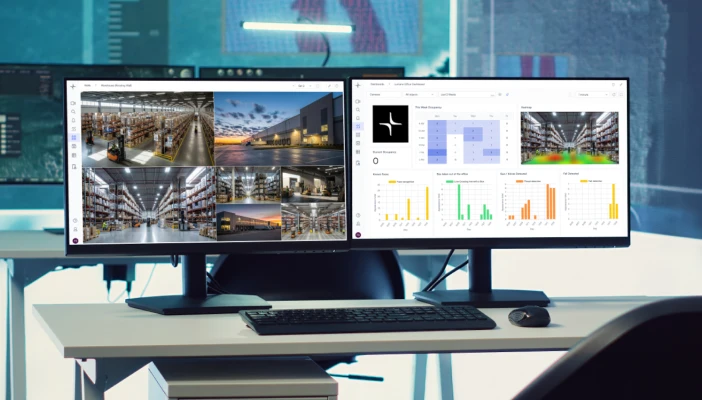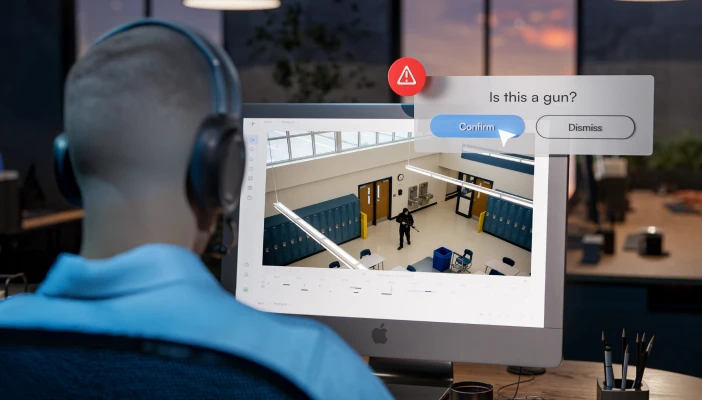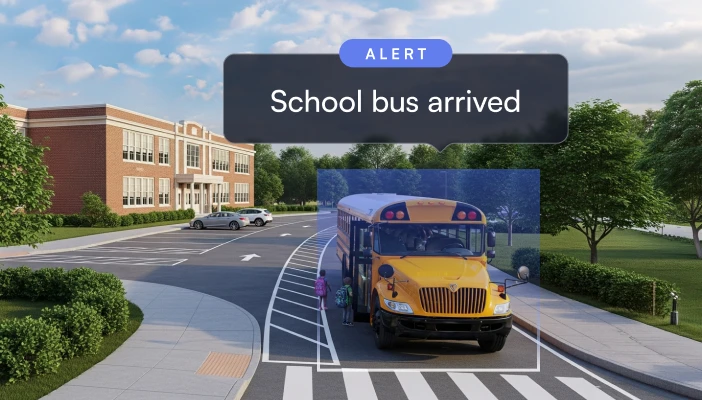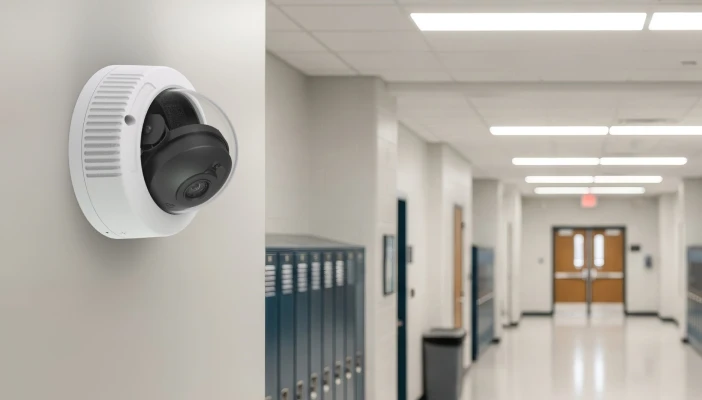Video surveillance, once a tool primarily used for reviewing incidents after they occurred, has evolved into a proactive system that supports safety, operations, and real-time decision-making. Advances in hardware, architecture, and AI enable enterprises to detect and respond to issues more quickly, investigate them more efficiently, and make more informed decisions. The global video surveillance market reflects the shift: totaling around $73.8B in 2024, and trending toward $147.7B by 2030 as AI, cloud computing, and edge processing reshape what’s possible.
To help you learn more and make an informed purchase decision, this guide covers the evolution of video surveillance, the benefits modern systems deliver, how AI enables those benefits, and a checklist to help you choose the right enterprise solution.
Key Highlights
- Video surveillance has evolved from a reactive evidence-gathering tool to a real-time intelligence-gathering system.
- AI video surveillance enables earlier detection and response, faster investigations, and fewer false alerts.
- Hybrid-cloud systems combine local resilience with cloud scalability and management.
- AI adds value beyond security, improving compliance, safety, and operational efficiency.
- Choosing the right system depends on factors such as architecture, bandwidth, compliance, and scalability requirements.
Table of Contents
- How Video Surveillance Has Evolved
- Types of Enterprise Video Surveillance Systems
- Selecting the Best Video Surveillance System
- How AI Enhances Enterprise Video Surveillance
- Modernize Your Enterprise Security with Lumana
How Video Surveillance Has Evolved
The story of video surveillance is one of steady transformation. Surveillance began with analog CCTV (Closed-Circuit Television)—closed systems that recorded to tapes or DVRs and required manual review after incidents. These systems offered basic visibility but were labor-intensive and reactive.
The introduction of IP network cameras in the late 1990s was a turning point. Video could now be streamed over networks, stored digitally, and accessed remotely. Enterprises gained flexibility and scale, but the systems still mostly documented what happened rather than providing real-time insight.
Today, AI-driven video surveillance marks the beginning of a new era. Instead of passively recording, systems can detect unusual behaviors, filter out false positives, and trigger alerts and actions as events unfold. The evolution is clear: video has become a driving force in safety, security, and operational decision-making.
Types of Enterprise Video Surveillance Systems
Enterprises often face a choice between legacy and modern surveillance architectures. When evaluating solutions, ensure they align with your network, compliance requirements, and growth plans. Many enterprises ultimately favor hybrid cloud because it delivers local performance with cloud-level visibility, governance, and redundancy.
Here’s how the core system types compare.
Analog (CCTV + DVR):
- Pros: Mature, low complexity, and proven for small footprints.
- Cons: Limited resolution, searchability, and integration options, typically reactive only.
- Best for: Legacy environments with basic coverage requirements.
IP + NVR:
- Pros: Higher image quality than analog, networked storage, a mature ecosystem, and predictable on-premises performance.
- Cons: Hardware-intensive, less flexible at scale, and limited cross-site visibility without additional tooling.
- Best for: Single or few sites with reliable local IT resources.
Cloud NVR:
- Pros: Centralized access, elastic capacity, provider-managed updates, simplified multi-site rollouts.
- Cons: Dependent on a stable uplink, recurring OPEX, possible egress fees, variable retrieval speed.
- Best for: Distributed teams prioritizing remote access and fast scaling with minimal on-site equipment.
Hybrid-cloud:
- Pros: Local recording and instant playback, centralized cloud management, cross-site search, and automatic cloud backup. Operates through internet outages and backfills when online.
- Cons: More on-site components to configure and monitor than single-mode setups.
- Best for: Multi-site organizations that need resilience, greater system and AI performance, bandwidth control, and unified administration.
Selecting the Best Video Surveillance System
When evaluating vendors, start with outcomes, not features. Clarify which risks you need to mitigate, who will use the system, and what constraints (such as retention, bandwidth, or compliance) apply. Make trade-offs explicit up front. Use the questions below to inform your decisions and avoid overbuying or vendor lock-in.
- Define objectives: What outcomes do we need—security only, or also safety, compliance, and operations?
- Architecture: Which model fits us (analog, IP, cloud, or hybrid), and how does it behave during outages?
- Retention: What policies do regulation, legal hold, and business risk require?
- Bandwidth model: Can our network handle continuous recording and upload, as well as backfill after outages?
- AI scope: Do we need basic motion detection, or behavior recognition and natural-language search?
- Integrations: Which systems must it connect to—access control, sensors, alarms, IT systems, and export workflows?
- Governance: Do we have encryption, audit logs, SSO, and role-based access controls in place?
- Scalability: Can we add sites, cameras, and users without re-architecture or license friction?
- Total cost: How do CapEx, OpEx, support, and lifecycle replacement compare over time?
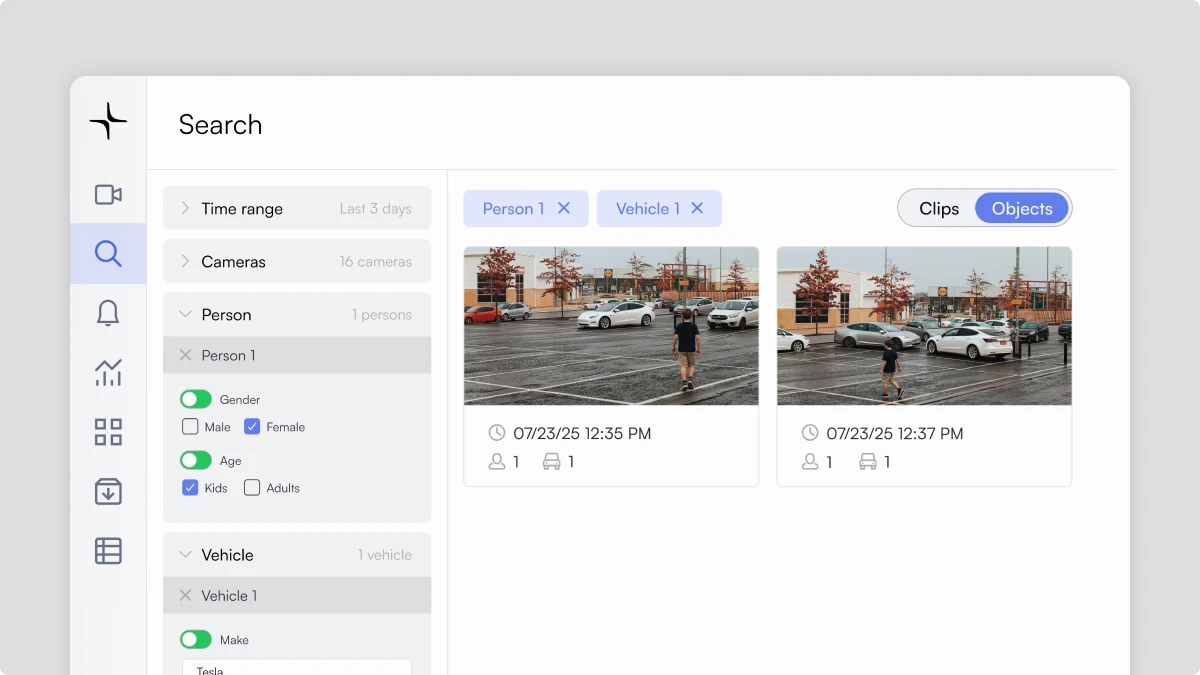
How AI Enhances Enterprise Video Surveillance
As stated earlier, AI enables video to shift from passive recording to real-time intelligence. Teams get faster, clearer action: shorter time between risk and response, fewer false alerts, and investigations that take seconds instead of hours. Beyond security, AI supports compliance, safety, and operational improvement. This shift isn’t about replacing humans; it’s about giving them better signals, faster answers, and tools that cut through hours of video noise.
Key benefits
- Deter and detect crime: Visible camera coverage reduces theft and vandalism, while AI identifies threats like weapons, vandalism, and after-hours entry and sends timely alerts.
- Faster investigations: Natural-language and layered search (“show a red jacket near the main entrance at 10 pm”) quickly surfaces exact clips and related moments.
- Fewer false alarms: Context-aware models filter out shadows, glare, and weather, allowing teams to focus on real risks.
- Protect employees: Detect missing PPE, blocked egress routes, and near-miss incidents in real time, enabling supervisors to intervene.
- Compliance support: Automated logs, role-based access, and audit-ready video evidence streamline inspections and ensure compliance.
- Operational efficiency: Dashboards convert video into actionable metrics, such as queue length, dwell time, and dock utilization, revealing bottlenecks and trends.
Compared to traditional systems, modern AI video surveillance delivers clear advantages in accuracy, speed, and scalability:

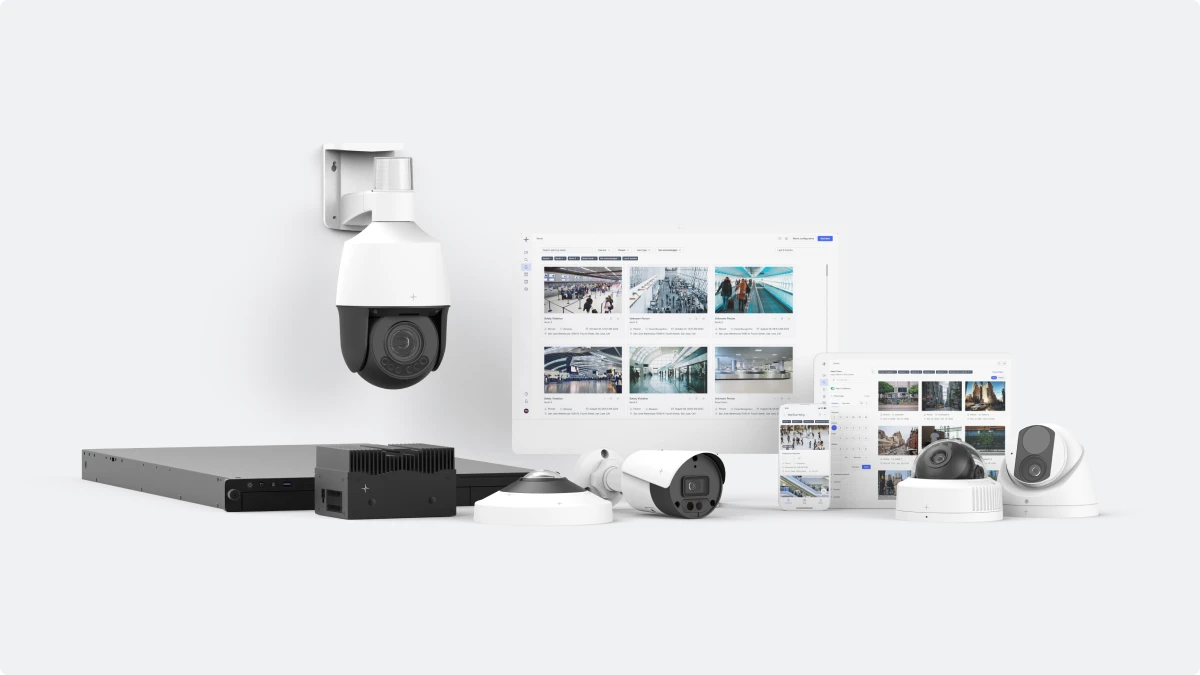
Modernize Your Enterprise Security with Lumana
Lumana’s hybrid-cloud, AI-powered video security system transforms cameras from passive recorders into real-time intelligence. The platform integrates seamlessly with your environment, delivers timely alerts, and scales across sites without forcing a rip-and-replace approach.
Built to work with any IP camera, Lumana pairs local performance with cloud-level visibility for resilient recording, fast playback, and centralized management. Context-aware AI reduces false alerts, while natural-language, multi-attribute search turns investigations from hours into seconds. Customizable dashboards translate video into operational metrics for safety, compliance, and efficiency.
With robust cybersecurity, role-based access, and audit-ready logs, Lumana enables enterprises to modernize with confidence. Whether you’re securing one facility or a global footprint, you get speed, accuracy, and scale in one centralized platform.
Ready to see how Lumana can elevate your security and operations?
Request a demo today and discover the difference AI video security can make for your organization.
Discover the power of AI video security
Related Articles
Visual intelligence
Dec 3, 2025
How AI-Powered Video Analytics Cut False Alarms by Up to 90%
Product news
Nov 25, 2025
November Product Update: Custom Objects, 24/7 Support, and Multiple Integrations
Workplace safety
Nov 20, 2025
Why AI Accuracy Matters in School Safety: Lessons From Recent Failures
Sign up for the Webinar
Submitted information will be used in accordance with our Privacy Policy.
Video surveillance, once a tool primarily used for reviewing incidents after they occurred, has evolved into a proactive system that supports safety, operations, and real-time decision-making. Advances in hardware, architecture, and AI enable enterprises to detect and respond to issues more quickly, investigate them more efficiently, and make more informed decisions. The global video surveillance market reflects the shift: totaling around $73.8B in 2024, and trending toward $147.7B by 2030 as AI, cloud computing, and edge processing reshape what’s possible.
To help you learn more and make an informed purchase decision, this guide covers the evolution of video surveillance, the benefits modern systems deliver, how AI enables those benefits, and a checklist to help you choose the right enterprise solution.
Key Highlights
- Video surveillance has evolved from a reactive evidence-gathering tool to a real-time intelligence-gathering system.
- AI video surveillance enables earlier detection and response, faster investigations, and fewer false alerts.
- Hybrid-cloud systems combine local resilience with cloud scalability and management.
- AI adds value beyond security, improving compliance, safety, and operational efficiency.
- Choosing the right system depends on factors such as architecture, bandwidth, compliance, and scalability requirements.
Table of Contents
- How Video Surveillance Has Evolved
- Types of Enterprise Video Surveillance Systems
- Selecting the Best Video Surveillance System
- How AI Enhances Enterprise Video Surveillance
- Modernize Your Enterprise Security with Lumana
How Video Surveillance Has Evolved
The story of video surveillance is one of steady transformation. Surveillance began with analog CCTV (Closed-Circuit Television)—closed systems that recorded to tapes or DVRs and required manual review after incidents. These systems offered basic visibility but were labor-intensive and reactive.
The introduction of IP network cameras in the late 1990s was a turning point. Video could now be streamed over networks, stored digitally, and accessed remotely. Enterprises gained flexibility and scale, but the systems still mostly documented what happened rather than providing real-time insight.
Today, AI-driven video surveillance marks the beginning of a new era. Instead of passively recording, systems can detect unusual behaviors, filter out false positives, and trigger alerts and actions as events unfold. The evolution is clear: video has become a driving force in safety, security, and operational decision-making.
Types of Enterprise Video Surveillance Systems
Enterprises often face a choice between legacy and modern surveillance architectures. When evaluating solutions, ensure they align with your network, compliance requirements, and growth plans. Many enterprises ultimately favor hybrid cloud because it delivers local performance with cloud-level visibility, governance, and redundancy.
Here’s how the core system types compare.
Analog (CCTV + DVR):
- Pros: Mature, low complexity, and proven for small footprints.
- Cons: Limited resolution, searchability, and integration options, typically reactive only.
- Best for: Legacy environments with basic coverage requirements.
IP + NVR:
- Pros: Higher image quality than analog, networked storage, a mature ecosystem, and predictable on-premises performance.
- Cons: Hardware-intensive, less flexible at scale, and limited cross-site visibility without additional tooling.
- Best for: Single or few sites with reliable local IT resources.
Cloud NVR:
- Pros: Centralized access, elastic capacity, provider-managed updates, simplified multi-site rollouts.
- Cons: Dependent on a stable uplink, recurring OPEX, possible egress fees, variable retrieval speed.
- Best for: Distributed teams prioritizing remote access and fast scaling with minimal on-site equipment.
Hybrid-cloud:
- Pros: Local recording and instant playback, centralized cloud management, cross-site search, and automatic cloud backup. Operates through internet outages and backfills when online.
- Cons: More on-site components to configure and monitor than single-mode setups.
- Best for: Multi-site organizations that need resilience, greater system and AI performance, bandwidth control, and unified administration.
Selecting the Best Video Surveillance System
When evaluating vendors, start with outcomes, not features. Clarify which risks you need to mitigate, who will use the system, and what constraints (such as retention, bandwidth, or compliance) apply. Make trade-offs explicit up front. Use the questions below to inform your decisions and avoid overbuying or vendor lock-in.
- Define objectives: What outcomes do we need—security only, or also safety, compliance, and operations?
- Architecture: Which model fits us (analog, IP, cloud, or hybrid), and how does it behave during outages?
- Retention: What policies do regulation, legal hold, and business risk require?
- Bandwidth model: Can our network handle continuous recording and upload, as well as backfill after outages?
- AI scope: Do we need basic motion detection, or behavior recognition and natural-language search?
- Integrations: Which systems must it connect to—access control, sensors, alarms, IT systems, and export workflows?
- Governance: Do we have encryption, audit logs, SSO, and role-based access controls in place?
- Scalability: Can we add sites, cameras, and users without re-architecture or license friction?
- Total cost: How do CapEx, OpEx, support, and lifecycle replacement compare over time?

How AI Enhances Enterprise Video Surveillance
As stated earlier, AI enables video to shift from passive recording to real-time intelligence. Teams get faster, clearer action: shorter time between risk and response, fewer false alerts, and investigations that take seconds instead of hours. Beyond security, AI supports compliance, safety, and operational improvement. This shift isn’t about replacing humans; it’s about giving them better signals, faster answers, and tools that cut through hours of video noise.
Key benefits
- Deter and detect crime: Visible camera coverage reduces theft and vandalism, while AI identifies threats like weapons, vandalism, and after-hours entry and sends timely alerts.
- Faster investigations: Natural-language and layered search (“show a red jacket near the main entrance at 10 pm”) quickly surfaces exact clips and related moments.
- Fewer false alarms: Context-aware models filter out shadows, glare, and weather, allowing teams to focus on real risks.
- Protect employees: Detect missing PPE, blocked egress routes, and near-miss incidents in real time, enabling supervisors to intervene.
- Compliance support: Automated logs, role-based access, and audit-ready video evidence streamline inspections and ensure compliance.
- Operational efficiency: Dashboards convert video into actionable metrics, such as queue length, dwell time, and dock utilization, revealing bottlenecks and trends.
Compared to traditional systems, modern AI video surveillance delivers clear advantages in accuracy, speed, and scalability:


Modernize Your Enterprise Security with Lumana
Lumana’s hybrid-cloud, AI-powered video security system transforms cameras from passive recorders into real-time intelligence. The platform integrates seamlessly with your environment, delivers timely alerts, and scales across sites without forcing a rip-and-replace approach.
Built to work with any IP camera, Lumana pairs local performance with cloud-level visibility for resilient recording, fast playback, and centralized management. Context-aware AI reduces false alerts, while natural-language, multi-attribute search turns investigations from hours into seconds. Customizable dashboards translate video into operational metrics for safety, compliance, and efficiency.
With robust cybersecurity, role-based access, and audit-ready logs, Lumana enables enterprises to modernize with confidence. Whether you’re securing one facility or a global footprint, you get speed, accuracy, and scale in one centralized platform.
Ready to see how Lumana can elevate your security and operations?
Request a demo today and discover the difference AI video security can make for your organization.



